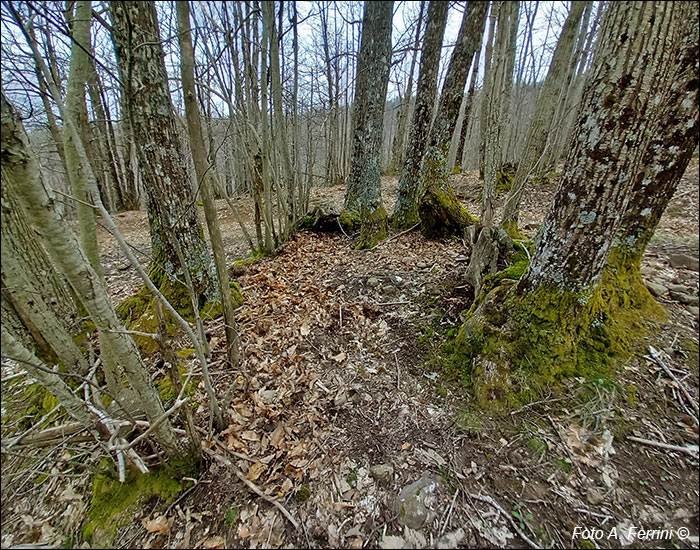Dal piccolo borgo di Capraia a Santa Trinita
Il sentiero da Capraia a Badia Santa Trinita e possibile ritorno su due percorsi diversi
Italiano
LUOGHI E PERCORSI NEI PRESSI DI BADIA SANTA TRINITA 54
Camminando in questo bosco passiamo accanto a diverse situazioni come quella che mostra questa foto, ma non siamo consapevoli di cosa si tratta. Osserviamo meglio. Le sette/otto piante che vediamo sono nate e cresciute secondo una precisa logica, ossia su perimetro di un fusto di un unico castagno, ossia una pianta che aveva un diametro alla base di circa quattro metri.
Che fine hanno fatto questi giganti del bosco? Furono abbattuti negli anni Venti del Novecento per fornire legno di castagno alla Fabbrica del Tannino sorta in quel periodo a Bibbiena. I castagni vecchi hanno più contenuto tannico, è per questo che si abbatevano queste piante (con un lavoro immenso) ormai divenute poco produttive come quantità di castagne (i castagni monumentali che vediamo oggi, quasi secchi, erano allora al massimo della produttività). Per facilitare e velocizzare l'esbosco di questo legnane, l'azienda tannica di Bibbiena aveva realizzato una teleferica (come in altre parti del Pratomagno) che dalla zona del Pratolino (poco più in basso, vi passeremo tra poco) trasportava il legname fino a Talla dove veniva caricato su carri trainati da cavalli e portato a Bibbiena. La funivia cessò di funzionare nel decennio successivo, per la fine del legno adeguato a quest'uso.
Walking in this forest we pass by various situations like the one shown in this photo, but we are not aware of what it is. Let's take a closer look. The seven/eight plants that we see were born and grown according to a precise logic, that is, on the perimeter of a trunk of a single chestnut tree, that is, a plant that had a diameter at the base of approximately four meters.
What happened to these forest giants? They were felled in the 1920s to supply chestnut wood to the Tannin Factory built in Bibbiena at that time. Old chestnut trees have a higher tannic content, which is why these plants were cut down (with immense work) which had now become less productive in terms of quantity of chestnuts (the monumental chestnut trees that we see today, almost dry, were then at their peak productivity). To facilitate and speed up the removal of this wood, the tannic company of Bibbiena had built a cableway (as in other parts of Pratomagno) which from the Pratolino area (a little further down, we will pass there shortly) transported the wood up to Talla where it was loaded onto horse-drawn carts and taken to Bibbiena. The cable car stopped working in the following decade, due to the end of the wood suitable for this use.











































































































